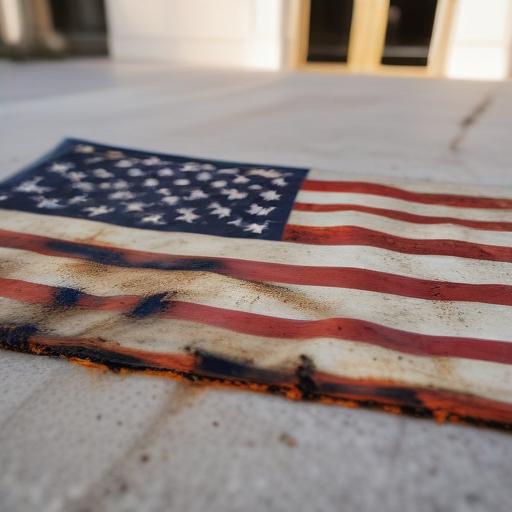Flag burning debate continues as a veteran’s protest near the White House tests legal lines
WASHINGTON — A North Carolina Army veteran set an American flag ablaze outside the White House on Monday evening, hours after President Trump announced an executive order aimed at charging flag burners with inciting riots and mandating a year in jail for such acts.
Legal precedent has long protected flag desecration as free speech. The Supreme Court ruled in 1990 that a law banning flag burning violated the First Amendment, saying the attempt to suppress expression outweighed any symbolic interest in preserving the flag.
Trump framed the executive move as necessary to curb violence, saying the act “incites riots at levels we’ve never seen before” and arguing for a mandatory one-year sentence. The White House did not specify how the order would be implemented, but the proclamation set the stage for potential new prosecutions.
The demonstrator, Jay Carey, a 54-year-old veteran from Arden, North Carolina, burned the flag in Lafayette Park in front of the White House. He was detained around 6:15 p.m. and arrested shortly afterward by Secret Service agents, then turned over to U.S. Park Police, which handles park concerns. In video footage, Carey identifies himself as a more than two-decade combat veteran and gives a short speech before lighting the flag.
Carey told local reporters that he believed there is a First Amendment right to burn the flag and argued that no president or Congress can infringe on those rights. He was later released with two citations—one for starting a fire without a container and another for starting a fire on park grounds and causing damage—though he said no damage occurred.
He said his decision to burn the flag stemmed from the executive order and his view of the atmosphere surrounding it, insisting his action was a test of constitutional boundaries rather than a gesture aimed at harm. He added that if charged under the new order, he and his lawyers are ready to take the case to the Supreme Court.
Carey was part of a small veteran group in Washington protesting the deployment of National Guard troops on U.S. soil, with the aim of mobilizing more people to participate in demonstrations. He also noted a prior incident in March, when he was escorted from a town hall in Asheville, North Carolina, after shouting at a congressman.
Context and outlook
– The incident highlights a central tenet of American civics: free speech protections can cover provocative acts, including flag desecration, even when such acts generate strong public backlash.
– Legal observers will be watching closely how authorities enforce any new charges tied to the president’s order, given existing First Amendment standards that limit criminal penalties for symbolic expression.
– The episode also underscores ongoing debates over the balance between safeguarding national symbols and preserving the right to protest, especially amid political tensions and concerns about civil disorder.
Positive note
Despite the tensions, the episode reinforces the robustness of democratic dialogue in the United States—where protests and counterprotests rapidly become focal points for discussion about constitutional rights, public order, and the limits of political power.
Summary
A veteran’s flag-burning protest near the White House follows a presidential push to expand penalties for flag desecration, despite long-standing Supreme Court rulings protecting such expression. The incident foregrounds ongoing disputes over symbolic speech, executive powers, and citizens’ ability to challenge leadership through protest.
Potential takeaways
– The confrontation spotlights how symbolic acts intersect with evolving interpretations of speech protections.
– Lawyers and lawmakers may begin shaping concrete responses as officials outline how the new order would be implemented in practice.
– The broader public discourse around national symbols and civil liberties is likely to persist as protests and counterprotests continue to unfold.
